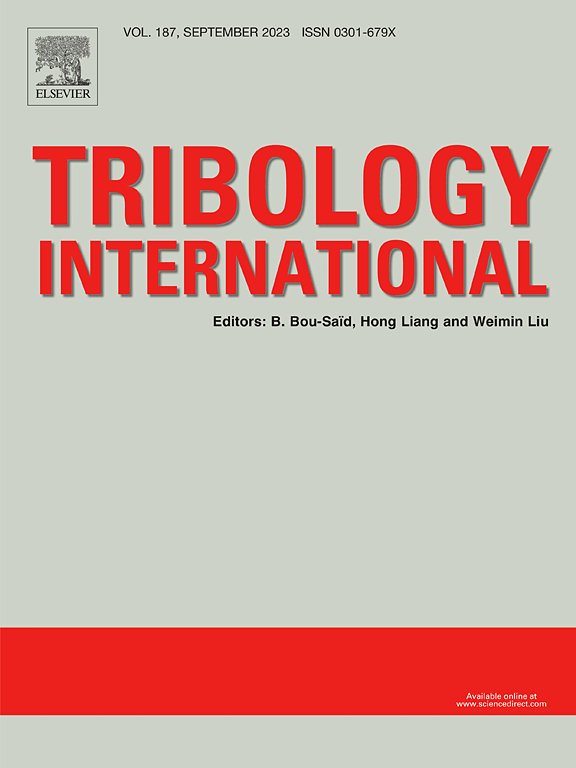石墨烯增强多晶高熵合金摩擦学性能:纳米尺度模拟与实验研究
IF 6.1
1区 工程技术
Q1 ENGINEERING, MECHANICAL
引用次数: 0
摘要
本研究通过分子动力学模拟和纳米划痕实验研究了石墨烯对多晶FeNiCrCoCu高熵合金(HEAs)纳米尺度摩擦学行为的影响。结果表明,石墨烯的吸附显著提高了HEAs的减摩性和耐磨性。石墨烯作为固体润滑剂,形成均匀的界面层,改善了热耗散、位错演化和应力分布。这减少了磨损碎片的堆积,从而减少了摩擦引起的损伤。四层石墨烯实现了界面润滑、应力缓冲和导热性的最佳平衡,使HEAs的摩擦系数降至0.121,比原始HEAs降低了68.66 %。纳米刮擦实验进一步表明,适量石墨烯的使用导致分散均匀,促进了稳定润滑层的形成,从而使摩擦系数降低到0.093,比原始HEAs降低了39.61 %。这项工作为优化石墨烯增强HEAs以提高纳米级摩擦学性能提供了见解,为高性能涂层和微机电系统提供了潜在的应用。本文章由计算机程序翻译,如有差异,请以英文原文为准。
Graphene-enhanced tribological performance of polycrystalline high-entropy alloys: Nanoscale simulation and experimental investigation
This study investigates the influence of graphene on the nanoscale tribological behavior of polycrystalline FeNiCrCoCu high-entropy alloys (HEAs) using molecular dynamics simulations and nano-scratch experiments. The results reveal that the adsorption of graphene significantly enhances the friction reduction and wear resistance of HEAs. Graphene acts as a solid lubricant to form a uniform interfacial layer, which improves thermal dissipation, dislocation evolution and stress distribution. This mitigates wear debris accumulation and thus reduces friction-induced damage. The four-layer graphene achieves the optimal balance of interfacial lubrication, stress buffering and thermal conductivity, reducing the friction coefficient of HEAs to 0.121, a 68.66 % reduction compared to raw HEAs. Nano-scratching experiments further show that the use of moderate graphene leads to even dispersion, which promotes the formation of a stable lubricating layer, thereby reducing the friction coefficient to 0.093, a 39.61 % decrease compared to raw HEAs. This work provides insights into optimizing graphene-enhanced HEAs for improved nanoscale tribological performance, offering potential applications in high-performance coatings and microelectromechanical systems.
求助全文
通过发布文献求助,成功后即可免费获取论文全文。
去求助
来源期刊

Tribology International
工程技术-工程:机械
CiteScore
10.10
自引率
16.10%
发文量
627
审稿时长
35 days
期刊介绍:
Tribology is the science of rubbing surfaces and contributes to every facet of our everyday life, from live cell friction to engine lubrication and seismology. As such tribology is truly multidisciplinary and this extraordinary breadth of scientific interest is reflected in the scope of Tribology International.
Tribology International seeks to publish original research papers of the highest scientific quality to provide an archival resource for scientists from all backgrounds. Written contributions are invited reporting experimental and modelling studies both in established areas of tribology and emerging fields. Scientific topics include the physics or chemistry of tribo-surfaces, bio-tribology, surface engineering and materials, contact mechanics, nano-tribology, lubricants and hydrodynamic lubrication.
 求助内容:
求助内容: 应助结果提醒方式:
应助结果提醒方式:


